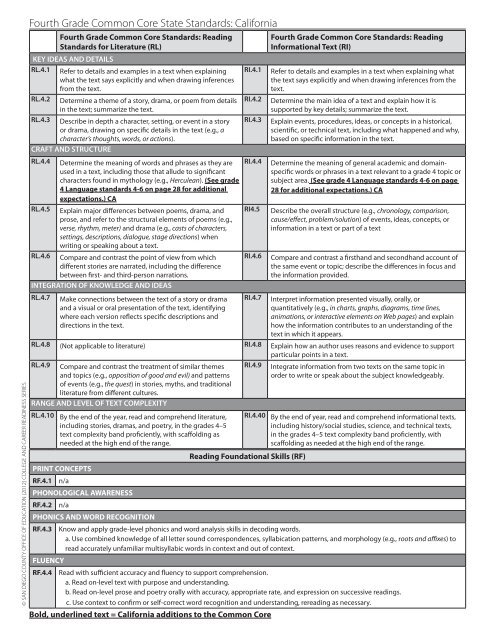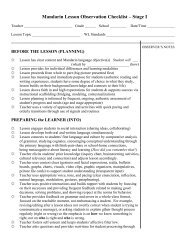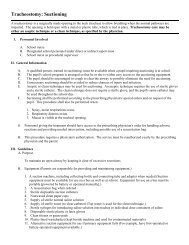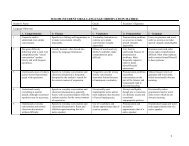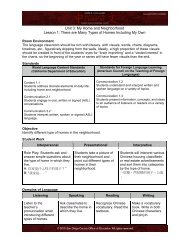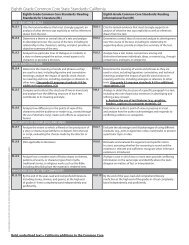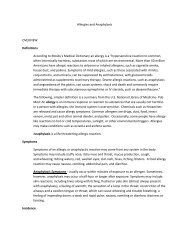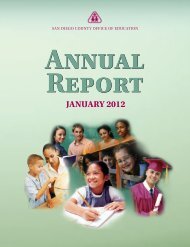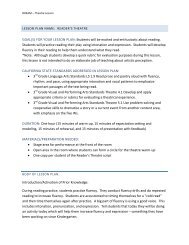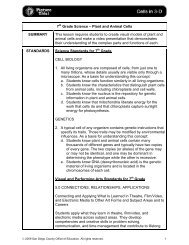Fourth Grade Common Core State Standards: California
Fourth Grade Common Core State Standards: California
Fourth Grade Common Core State Standards: California
Create successful ePaper yourself
Turn your PDF publications into a flip-book with our unique Google optimized e-Paper software.
<strong>Fourth</strong> <strong>Grade</strong> <strong>Common</strong> <strong>Core</strong> <strong>State</strong> <strong>Standards</strong>: <strong>California</strong>TEXT TYPES AND PURPOSESW.4.1W.4.2W.4.3Writing (W)Write opinion pieces on topics or texts, supporting a point of view with reasons and information.a. Introduce a topic or text clearly, state an opinion, and create an organizational structure in which related ideas are grouped tosupport the writer’s purpose.b. Provide reasons that are supported by facts and details.c. Link opinion and reasons using words and phrases (e.g., for instance, in order to, in addition).d. Provide a concluding statement or section related to the opinion presented.Write informative/explanatory texts to examine a topic and convey ideas and information clearly.a. Introduce a topic clearly and group related information in paragraphs and sections; include formatting (e.g., headings),illustrations, and multimedia when useful to aiding comprehension.b. Develop the topic with facts, definitions, concrete details, quotations, or other information and examples related to the topic.c. Link ideas within categories of information using words and phrases (e.g., another, for example, also, because).d. Use precise language and domain-specific vocabulary to inform about or explain the topic.e. Provide a concluding statement or section related to the information or explanation presented.Write narratives to develop real or imagined experiences or events using effective technique, descriptive details, and clear eventsequences.a. Orient the reader by establishing a situation and introducing a narrator and/or characters; organize an event sequence thatunfolds naturally.b. Use dialogue and description to develop experiences and events or show the responses of characters to situations.c. Use a variety of transitional words and phrases to manage the sequence of events.d. Use concrete words and phrases and sensory details to convey experiences and events precisely.e. Provide a conclusion that follows from the narrated experiences or events.PRODUCTION AND DISTRIBUTION OF WRITINGW.4.4W.4.5W.4.6Produce clear and coherent writing (including multiple-paragraph texts) in which the development and organization areappropriate to task, purpose, and audience. (<strong>Grade</strong>-specific expectations for writing types are defined in standards 1–3 above.) CAWith guidance and support from peers and adults, develop and strengthen writing as needed by planning, revising, and editing.(Editing for conventions should demonstrate command of Language standards 1–3 up to and including grade 4.)With some guidance and support from adults, use technology, including the Internet, to produce and publish writing as well as tointeract and collaborate with others; demonstrate sufficient command of keyboarding skills to type a minimum of one page in asingle sitting.RESEARCH TO BUILD AND PRESENT KNOWLEDGEW.4.7Conduct short research projects that build knowledge through investigation of different aspects of a topic.© SAN DIEGO COUNTY OFFICE OF EDUCATION (2012) COLLEGE AND CAREER READINESS SERIESW.4.8W.4.9Recall relevant information from experiences or gather relevant information from print and digital sources; take notes, paraphrase,and categorize information, and provide a list of sources.Draw evidence from literary or informational texts to support analysis, reflection, and research.a. Apply grade 4 Reading standards to literature (e.g., “Describe in depth a character, setting, or event in a story or drama, drawing onspecific details in the text [e.g., a character’s thoughts, words, or actions].”).b. Apply grade 4 Reading standards to informational texts (e.g., “Explain how an author uses reasons and evidence to supportparticular points in a text”).RANGE OF WRITINGW.4.10Write routinely over extended time frames (time for research, reflection, and revision) and shorter time frames (a single sitting or aday or two) for a range of discipline-specific tasks, purposes, and audiences.Bold, underlined text = <strong>California</strong> additions to the <strong>Common</strong> <strong>Core</strong>
<strong>Fourth</strong> <strong>Grade</strong> <strong>Common</strong> <strong>Core</strong> <strong>State</strong> <strong>Standards</strong>: <strong>California</strong>COMPREHENSION & COLLABORATIONSpeaking & ListeningSL.4.1 Engage effectively in a range of collaborative discussions (one-on-one, in groups, and teacher led) with diverse partners on grade 4topics and texts, building on others’ ideas and expressing their own clearly.a. Come to discussions prepared, having read or studied required material; explicitly draw on that preparation and otherinformation known about the topic to explore ideas under discussion.b. Follow agreed-upon rules for discussions and carry out assigned roles.c. Pose and respond to specific questions to clarify or follow up on information, and make comments that contribute to thediscussion and link to the remarks of others.d. Review the key ideas expressed and explain their own ideas and understanding in light of the discussion.SL.4.2SL.4.3Paraphrase portions of a text read aloud or information presented in diverse media and formats, including visually, quantitatively,and orally.Identify the reasons and evidence a speaker or media source provides to support particular pointsPRESENTATION OF KNOWLEDGE AND IDEASSL.4.4SL.4.5SL.4.6Report on a topic or text, tell a story, or recount an experience in an organized manner, using appropriate facts and relevant,descriptive details to support main ideas or themes; speak clearly at an understandable pace.a. Plan and deliver a narrative presentation that: relates ideas, observations, or recollections; provides a clear context; andincludes clear insight into why the event or experience is memorable. CAAdd audio recordings and visual displays to presentations when appropriate to enhance the development of main ideas or themes.Differentiate between contexts that call for formal English (e.g., presenting ideas) and situations where informal discourse isappropriate (e.g., small-group discussion); use formal English when appropriate to task and situation. (See grade 4 Languagestandards 1 and 3 for specific expectations.)© SAN DIEGO COUNTY OFFICE OF EDUCATION (2012) COLLEGE AND CAREER READINESS SERIESBold, underlined text = <strong>California</strong> additions to the <strong>Common</strong> <strong>Core</strong>
© SAN DIEGO COUNTY OFFICE OF EDUCATION (2012) COLLEGE AND CAREER READINESS SERIES<strong>Fourth</strong> <strong>Grade</strong> <strong>Common</strong> <strong>Core</strong> <strong>State</strong> <strong>Standards</strong>: <strong>California</strong>CONVENTIONS OF STANDARD ENGLISHL.4.1LanguageDemonstrate command of the conventions of standard English grammar and usage when writing or speaking.a. Write fluidly and legibly in cursive or joined italics.b. Use interrogative, relative pronouns (who, whose, whom, which, that) and relative adverbs (where, when, why).c. Form and use the progressive (e.g., I was walking; I am walking; I will be walking) verb tenses.d. Use modal auxiliaries (e.g., can, may, must) to convey various conditions.e. Order adjectives within sentences according to conventional patterns (e.g., a small red bag rather than a red small bag).f. Form and use prepositional phrases.g. Produce complete sentences, recognizing and correcting inappropriate fragments and run-ons.*h. Correctly use frequently confused words (e.g., to, too, two; there, their).*L4.2 Demonstrate command of the conventions of standard English capitalization, punctuation, and spelling when writing.a. Use correct capitalization.b. Use commas and quotation marks to mark direct speech and quotations from a text.c. Use a comma before a coordinating conjunction in a compound sentence.d. Spell grade-appropriate words correctly, consulting references as needed.KNOWLEDGE OF LANGUAGEL.4.3Use knowledge of language and its conventions when writing, speaking, reading, or listening.a. Choose words and phrases to convey ideas precisely.*b. Choose punctuation for effect.*c. Differentiate between contexts that call for formal English (e.g., presenting ideas) and situations where informal discourse isappropriate (e.g., small-group discussion).VOCABULARY ACQUISITION & USEL.4.4L.4.5L.4.6Determine or clarify the meaning of unknown and multiple-meaning words and phrases based on grade 4 reading and content,choosing flexibly from a range of strategies.a. Use context (e.g., definitions, examples, or restatements in text) as a clue to the meaning of a word or phrase.b. Use common, grade-appropriate Greek and Latin affixes and roots as clues to the meaning of a word (e.g., telegraph, photograph,autograph).c. Consult reference materials (e.g., dictionaries, glossaries, thesauruses), both print and digital, to find the pronunciation anddetermine or clarify the precise meaning of key words and phrases and to identify alternate word choices in all content areas.Demonstrate understanding of figurative language, word relationships, and nuances in word meanings.a. Explain the meaning of simple similes and metaphors (e.g., as pretty as a picture) in context.b. Recognize and explain the meaning of common idioms, adages, and proverbs.c. Demonstrate understanding of words by relating them to their opposites (antonyms) and to words with similar but not identicalmeanings (synonyms).Acquire and use accurately grade-appropriate general academic and domain-specific words and phrases, including those that signalprecise actions, emotions, or states of being (e.g., quizzed, whined, stammered) and that are basic to a particular topic (e.g., wildlife,conservation, and endangered when discussing animal preservation).Bold, underlined text = <strong>California</strong> additions to the <strong>Common</strong> <strong>Core</strong>


